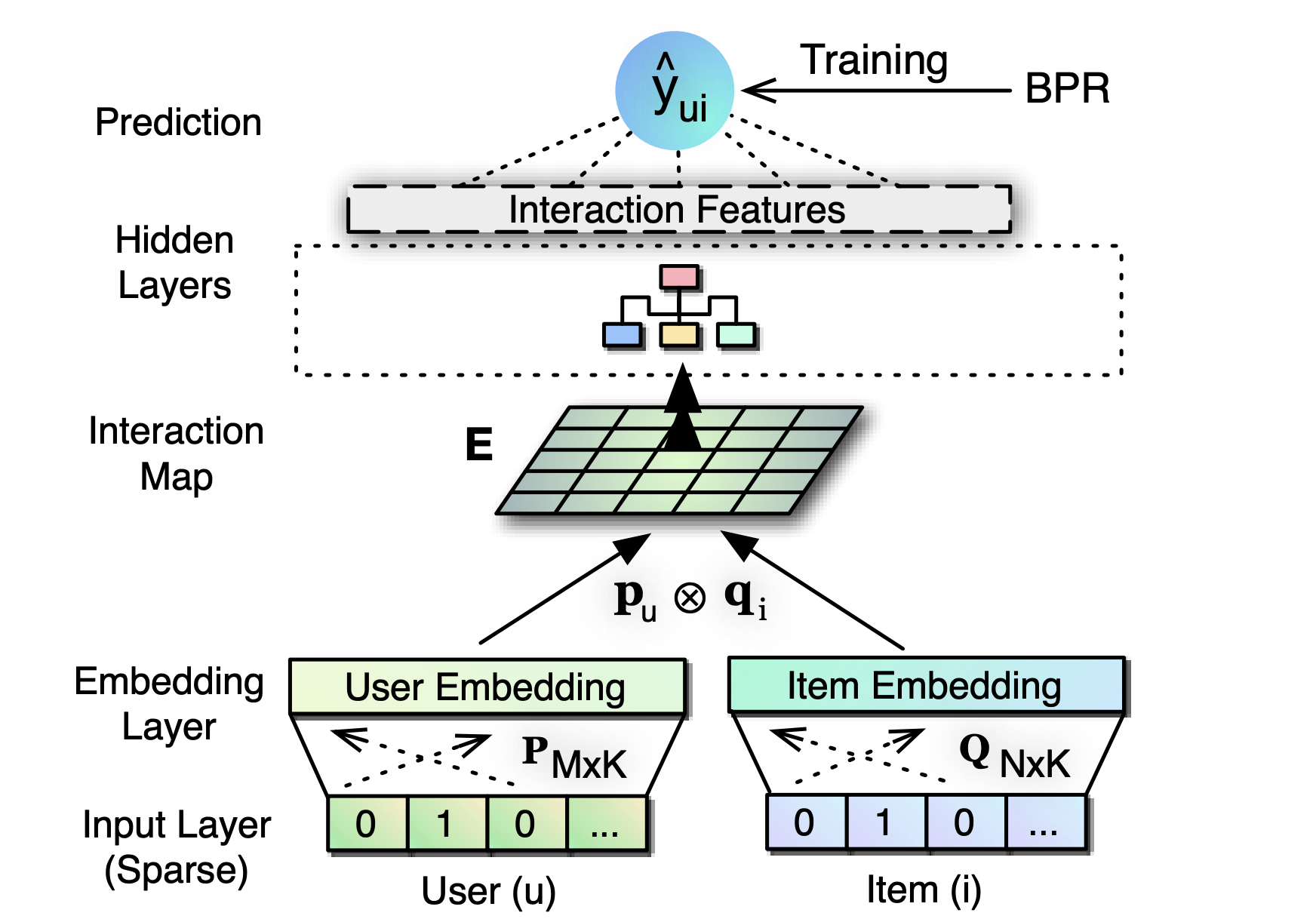ConvNCF¶
Introduction¶
Title: Outer Product-based Neural Collaborative Filtering
Authors: Xiangnan He, Xiaoyu Du, Xiang Wang, Feng Tian, Jinhui Tang and Tat-Seng Chua
Abstract: In this work, we contribute a new multi-layer neural network architecture named ONCF to perform collaborative filtering. The idea is to use an outer product to explicitly model the pairwise correlations between the dimensions of the embedding space. In contrast to existing neural recommender models that combine user embedding and item embedding via a simple concatenation or element-wise product, our proposal of using outer product above the embedding layer results in a two-dimensional interaction map that is more expressive and semantically plausible. Above the interaction map obtained by outer product, we propose to employ a convolutional neural network to learn high-order correlations among embedding dimensions. Extensive experiments on two public implicit feedback data demonstrate the effectiveness of our proposed ONCF framework, in particular, the positive effect of using outer product to model the correlations between embedding dimensions in the low level of multi-layer neural recommender model.

Running with RecBole¶
Model Hyper-Parameters:
embedding_size (int): The embedding size of users and items. Defaults to64.cnn_channels (list): The number of channels in each convolutional neural network layer. Defaults to[1, 32, 32, 32, 32].cnn_kernels (list): The size of convolutional kernel in each convolutional neural network layer. Defaults to[4, 4, 2, 2].cnn_strides (list): The strides of convolution in each convolutional neural network layer. Defaults to[4, 4, 2, 2].dropout_prob (float): The dropout rate in the linear predict layer. Defaults to0.2.reg_weights (list): The L2 regularization weights. Defaults to[0.1, 0.1].train_method (list): The training method. Defaults to'no_pretrain'. Range in['after_pretrain', 'no_pretrain'].pre_model_path (str): The path of pretrained model. Defaults to''.
A Running Example:
ConvNCF may have better performance by pretraining the embedding layer with BPR-MF according to the original paper. If you want to use ConvNCF without pretrain, please set train_method to 'no_pretrain' and just run.
Write the following code to a python file, such as run.py
from recbole.quick_start import run_recbole
config_dict = {
'train_method': 'no_pretrain',
}
run_recbole(model='ConvNCF', dataset='ml-100k', config_dict=config_dict)
And then:
python run.py
Otherwise, you should run BPR model first to pretrain the embedding layer. Write the following code to a python file, such as run_pretrain.py
from recbole.quick_start import run_recbole
run_recbole(model='BPR', dataset='ml-100k')
And then:
python run_pretrain.py
Then you can get the saved checkpoint path, for example, './saved/BPR-Feb-16-2023_19-23-29.pth'. Set train_method to 'no_pretrain'.
Write the following code to run_train.py
from recbole.quick_start import run_recbole
config_dict = {
'train_method': 'after_pretrain',
'pre_model_path': './saved/BPR-Feb-16-2023_19-23-29.pth',
}
run_recbole(model='ConvNCF', dataset='ml-100k', config_dict=config_dict)
And then:
python run_train.py
Tuning Hyper Parameters¶
If you want to use HyperTuning to tune hyper parameters of this model, you can copy the following settings and name it as hyper.test.
learning_rate choice [0.01,0.005,0.001,0.0005,0.0001]
dropout_prob choice [0.0,0.1,0.2,0.3,0.4,0.5]
cnn_channels choice ['[1,128,128,64,32]','[1,32,32,32,32,32,32]','[1,64,32,32,32,32]','[1,64,32,32,32]']
cnn_kernels choice ['[4,4,2,2]','[2,2,2,2,2,2]','[4,2,2,2,2]','[8,4,2]']
cnn_strides choice ['[4,4,2,2]','[2,2,2,2,2,2]','[4,2,2,2,2]','[8,4,2]']
reg_weights choice ['[0.1,0.1]','[0.2,0.2]']
Note that we just provide these hyper parameter ranges for reference only, and we can not guarantee that they are the optimal range of this model.
Then, with the source code of RecBole (you can download it from GitHub), you can run the run_hyper.py to tuning:
python run_hyper.py --model=[model_name] --dataset=[dataset_name] --config_files=[config_files_path] --params_file=hyper.test
For more details about Parameter Tuning, refer to Parameter Tuning.
If you want to change parameters, dataset or evaluation settings, take a look at